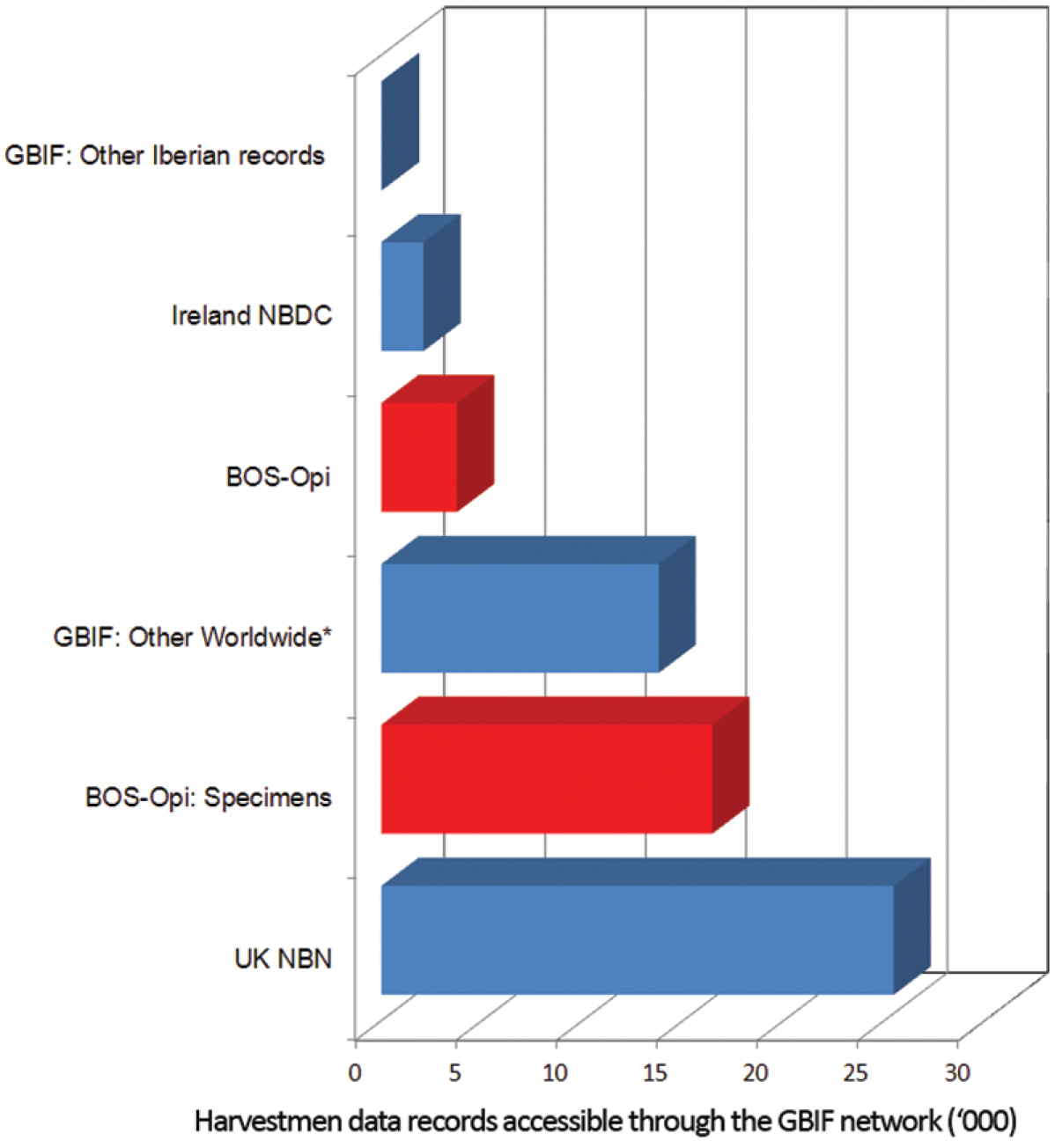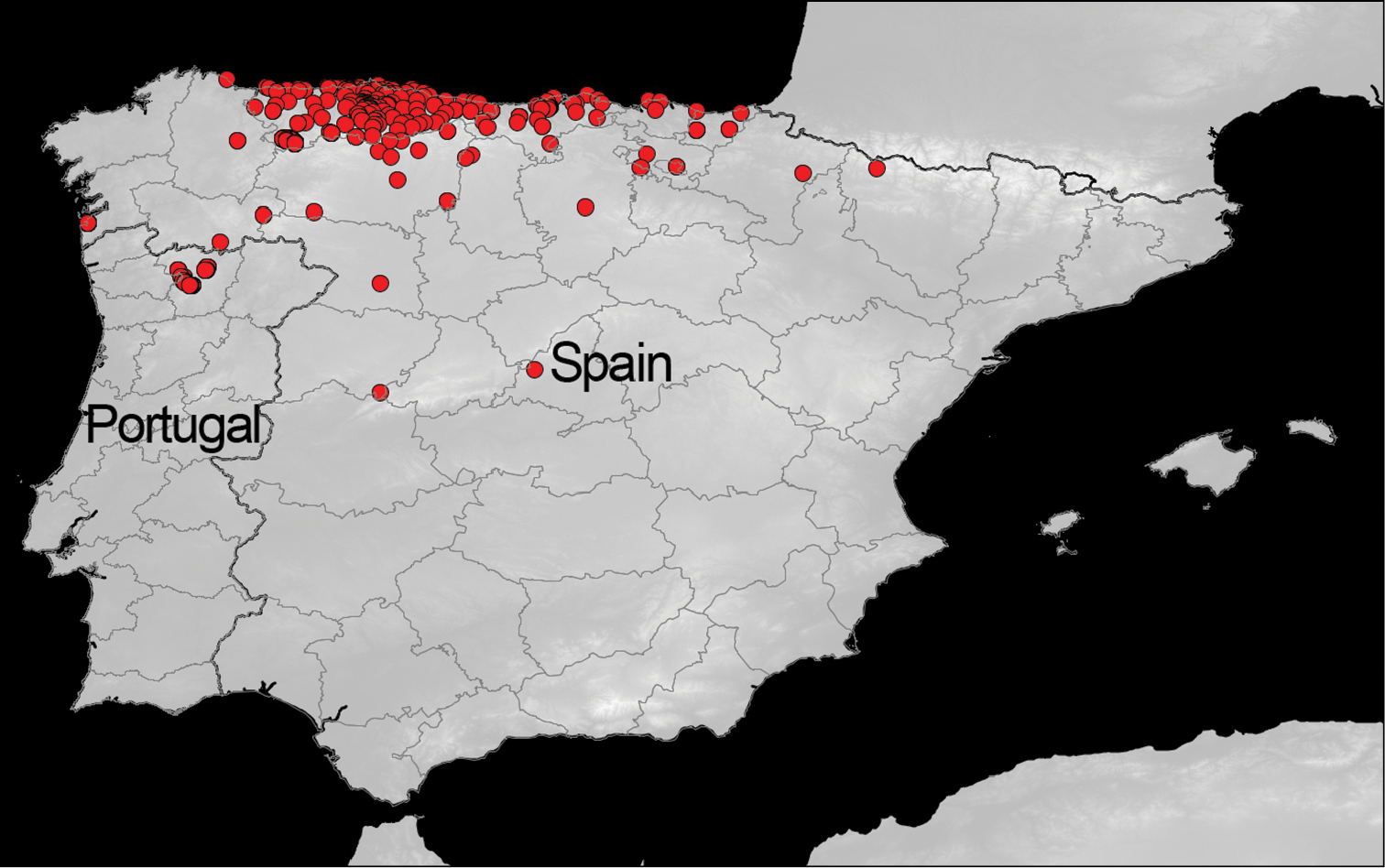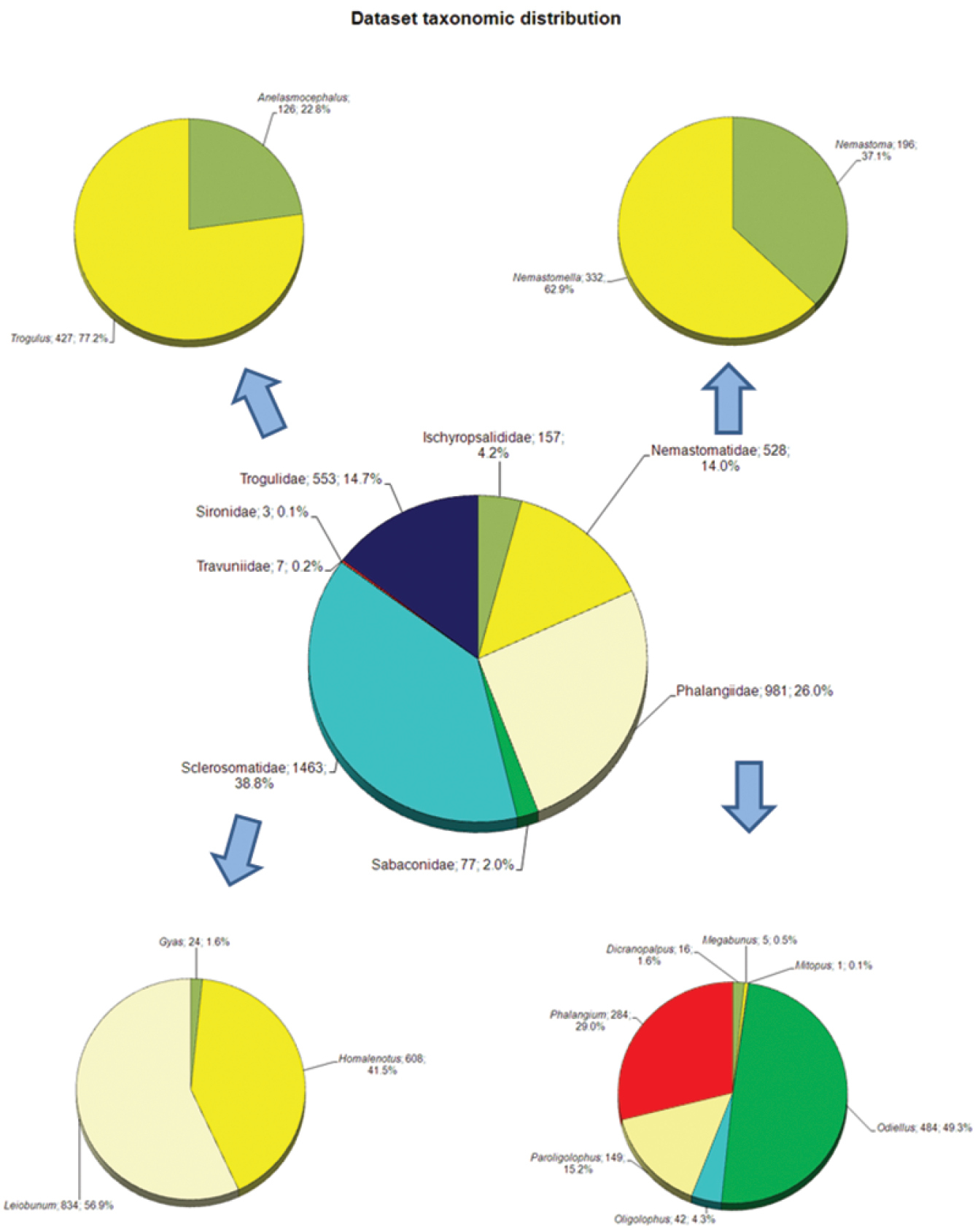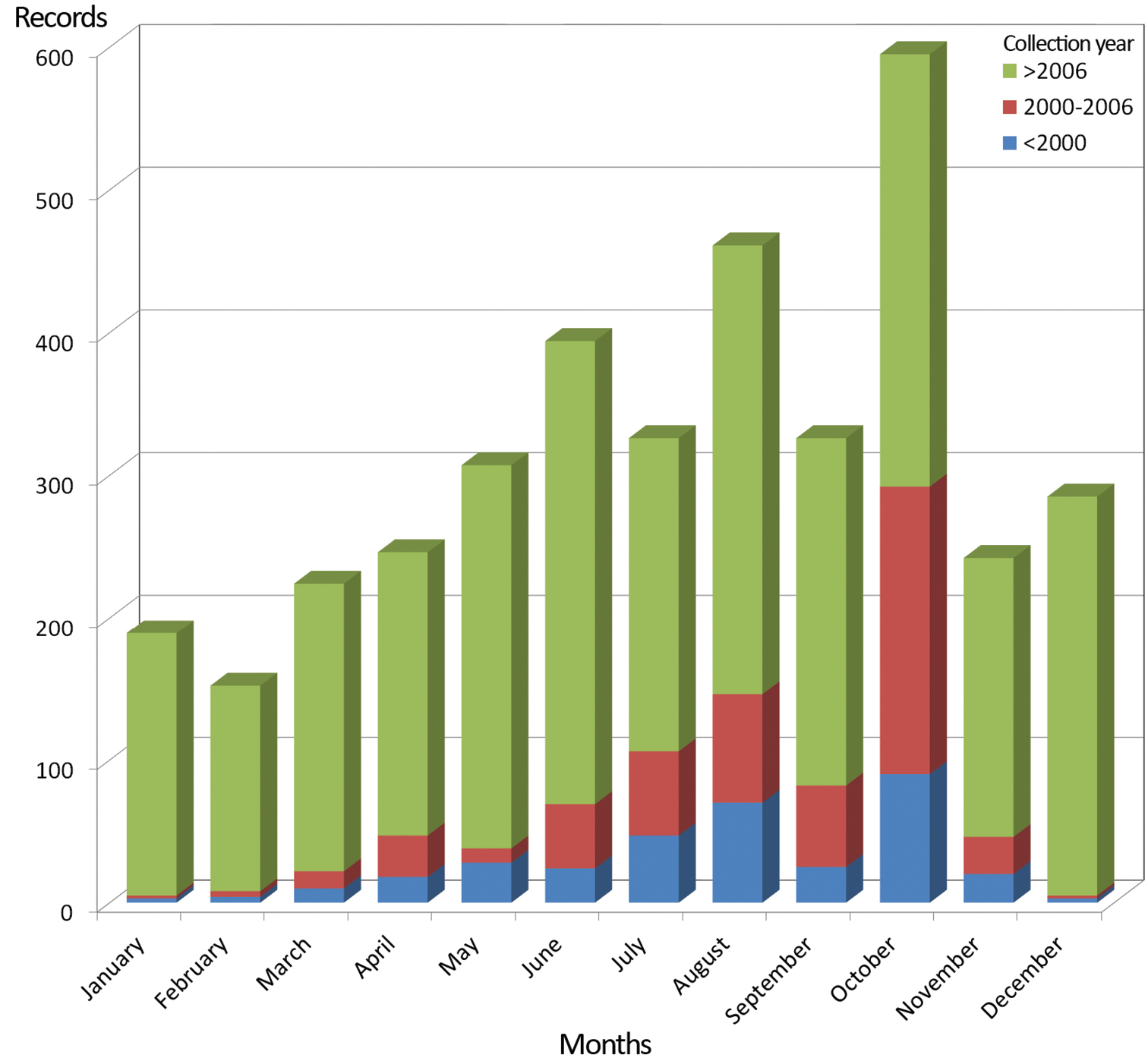






(C) 2013 Izaskun Merino-Sáinz. This is an open access article distributed under the terms of the Creative Commons Attribution License 3.0 (CC-BY), which permits unrestricted use, distribution, and reproduction in any medium, provided the original author and source are credited.
For reference, use of the paginated PDF or printed version of this article is recommended.
Citation: Merino-Sáinz I, Anadón A, Torralba-Burrial A (2013) Harvestmen of the BOS Arthropod Collection of the University of Oviedo (Spain) (Arachnida, Opiliones). ZooKeys 341: 21–36. doi: 10.3897/zookeys.341.6130 Resource ID: GBIF key: http://gbrds.gbif.org/browse/agent?uuid=cc0e6535-6bb4-4703-a32c-077f5e1176cd
Resource citation: Universidad de Oviedo (2013-). BOS Arthropod Collection Dataset: Opiliones (BOS-Opi). 3772 data records. Contributed by: Merino Sáinz I, Anadón A, Torralba-Burrial A, Fernández-Álvarez FA, Melero Cimas VX, Monteserín Real S, Ocharan Ibarra R, Rosa García R, Vázquez Felechosa MT, Ocharan FJ. Online at http://www.gbif.es:8080/ipt/archive.do?r=Bos-Opi and http://www.unioviedo.es/BOS/Zoologia/artropodos/opiliones, version 1.0 (last updated on 2013-06-30), GBIF key: http://gbrds.gbif.org/browse/agent?uuid=cc0e6535-6bb4-4703-a32c-077f5e1176cd, Data paper ID: doi: 10.3897/zookeys.341.6130
There are significant gaps in accessible knowledge about the distribution and phenology of Iberian harvestmen (Arachnida: Opiliones). Harvestmen accessible datasets in Iberian Peninsula are unknown, an only two other datasets available in GBIF are composed exclusively of harvestmen records. Moreover, only a few harvestmen data from Iberian Peninsula are available in GBIF network (or in any network that allows public retrieval or use these data). This paper describes the data associated with the Opiliones kept in the BOS Arthropod Collection of the University of Oviedo, Spain (hosted in the Department of Biología de Organismos y Sistemas), filling some of those gaps. The specimens were mainly collected from the northern third of the Iberian Peninsula. The earliest specimen deposited in the collection, dating back to the early 20th century, belongs to the P. Franganillo Collection. The dataset documents the collection of 16, 455 specimens, preserved in 3, 772 vials. Approximately 38% of the specimens belong to the family Sclerosomatidae, and 26% to Phalangidae; six other families with fewer specimens are also included. Data quality control was incorporated at several steps of digitisation process to facilitate reuse and improve accuracy. The complete dataset is also provided in Darwin Core Archive format, allowing public retrieval, use and combination with other biological, biodiversity of geographical variables datasets.
Opiliones, Arthropoda, Iberian Peninsula, entomological collections, biodiversity collections, distribution, datasets, Spain, Portugal
Purpose: Existing knowledge on the distribution of harvestmen in the Iberian Peninsula is still very fragmented (
BOS-Opi contributes significantly to the publicly accessible Harvestmen data records through the GBIF network.
The purpose of this paper is to document a dataset corresponding to Opiliones specimens deposited in the BOS Arthropod Collection (subcollection of Opiliones: BOS-Opi) of the University of Oviedo, Spain, comprising 16, 455 specimens in 3, 772 vials (each vial containing specimens with the same species/locality/date/capture method information, i.e., a single record). As a result of this, the BOS-Opi dataset makes a significant contribution of primary data about Iberian harvestmen for ecological, faunistic and conservation studies. With the publication of this dataset, we aim to (1) providing a dataset with phenological and distribution data on harvestmen from the northern third of the Iberian Peninsula, and (2) describing the Opiliones subcollection of the BOS Arthropod Collection.
Additional information: A list of publications citing harvestmen contained in this dataset (BOS-Opi) is provided in point 2 of the reference section.
Project title: Informatización de la Colección de Artrópodos BOS de la Universidad de Oviedo / Digitisation of the BOS Arthropod Collection of University of Oviedo
Personnel digitisation: Torralba-Burrial A
Administrative contact: Anadón A
BOS-Opi determination specialist: Merino Sáinz I
BOS-Opi collectors: Collectors who have deposited more than 50 specimens include Merino Sáinz I, Anadón A, Fernández-Álvarez F.A., Torralba-Burrial A, Ocharan Larrondo FJ, Melero Cimas VX, Monteserín Real S, Ocharan Ibarra R, Rosa García R, and Vázquez Felechosa MT
Curator of P. Franganillo Collection: Lastra C
Funding: Digitisation of this biological collection was supported by the Spanish National R+D+i Plan (MICINN, Spanish Government, grant ref. PTA2010-4108-I) and PCTI Asturias (Asturias Regional Government, ref. COF11-38) through a contract for ATB.
Almost 73% of the specimens were collected as part of the PhD Thesis by
Study area description: Harvestmen specimens deposited in BOS Arthropod Collection are from the northern third of the Iberian Peninsula (Figure 2). Most of this zone belongs to the Atlantic bioregion (from the Cantabrian Mountains to the Cantabrian Sea), with the Mediterranean bioregion in the south (the biogeographic regions are based on vegetation types as described by
BOS-Opi facilitates access to harvestmen specimen data collected from northern region of Iberian Peninsula.
Design description: The digitisation process of this dataset (BOS-Opi) was carried out according to the workflow put in place for the Odonata subcollection (BOS-Odo) (
Currently, dataset is being used to study phenological and life history differences of harvestmen species between areas in north Iberian Peninsula with different geographical/habitat features, species distribution and importance of opportunistic data in fill knowledge gaps when standardised sampling data are not available or are incomplete. Moreover, this dataset is considered as a dynamic catalogue of the harvestmen of BOS Arthropod Collection, allowing free access of citizens, researches, environmental companies and government managements to biodiversity data kept in this Collection.
General taxonomic coverage description: All specimens were identified to species when preservation status, sex and life cycle phase permitted it. Sixty-two species were recorded from the northern third of the Iberian Peninsula (
Taxonomic coverage of the BOS-Opi dataset.
No types are hosted among the Opiliones of the BOS Arthropod Collection. However, this collection does include the historic Collection of Arachnids P. Franganillo, with 17 specimens (in ten vials with BOS-Opi codes 3758-3767, five missing since the cataloguing of the collection by
Kingdom: Animalia
Phylum: Arthropoda
Class: Arachnida
Order: Opiliones
Family: Ischyropsalididae, Nemastomatidae, Phalangiidae, Sabaconidae, Sclerosomatidae, Sironidae, Travuniidae, Trogulidae.
Common names: Animals, Arthropods, Arachnids, Harvestmen.
All specimens are from the northern part of the Iberian Peninsula (Figure 2). Most of them are from Asturias province (89.58% of records with “species/locality/date”), with other specimens originating from Cantabria (6.86%), Tras-os-Montes (1.20%), Pontevedra (0.88%) and other provinces (León, Burgos, Álava, Guipúzcoa, Vizcaya, Lugo, Palencia, Ourense, Zamora, Huesca, Salamanca, Navarra and Madrid).
Parent collection identifier: Colección de Artrópodos BOS
Collection name: Colección de Artrópodos BOS de la Universidad de Oviedo: Opiliones (BOS-Opi)
Collection identifier: http://data.gbif.org/datasets/resource/15038
Specimen preservation method: Ethanol 70°
Curatorial unit: 3772 with an uncertainty of 0 (Vials (records))
Curatorial unit: 16455 with an uncertainty of 0 (Specimens)
Method description: The digitisation process of the Opiliones subcollection (BOS-Opi) was realised in accordance with the published workflow of the Odonata subcollection (BOS-Odo) (see
Pre-digitisation phase: The preservation status of harvestmen specimens was reviewed prior to digitisation. Vials were changed when necessary and refilled with preservation liquid (ethanol 70°). Specimens were identified or identifications were reviewed when they were already noted. Identification labels were added when labels were lacking or otherwise incomplete. Specimens’ vials were sorted alphabetically by family/genus/species names in trays, and hosted in metallic cabinets in a cold chamber.
Digitisation phase: A database with DarwinCore v1.2 standard fields and other fields specific to different research projects was developed using MS EXCEL software. All biodiversity data available on the specimens’ labels (i.e., specimen code, species identification and name of determiner, sex, number of specimens in the vial, locality, date, habitat, collector, collection method, research project and observations) were included in the database.
Other geographic data (municipality, GPS coordinates, altitude, etc.) from specimen labels or from associated publications were added to the database when available. If coordinates were not present on the specimen labels or in primary publications, retrospective georeferencing (see
The database was converted and imported to, and managed with, ZOORBAR v2.1.1 software (
Creation of the dataset: The dataset was exported as a file in DarwinCore v1.2 format and geographic coordinates were carried out with ZOORBAR v2.1.1 software. DarwinCore elements included in dataset structure are listed in the dataset description section. Data format, georeferenced coordinates and absence of ASCII anomalous characters were checked with DARWIN_TEST v.3.2 software (http://www.gbif.es/darwin_test/Darwin_test.php). Erroneous data were corrected and data cleaning was repeated to enhance the data quality (see details in the section on quality control).
The dataset was transformed to a DarwinCore Archive format with metadata to ensure rapid discovery of this biodiversity resource and future publishing as a citable academic paper (see
Study extent description: Specimens are mainly from the northern third of the Iberian Peninsula (see geographic coverage section). The earliest specimens are from the 20th century (belonging to the P. Franganillo collection), but the general collection starts in 1977. However, only 9.73% of the items were collected prior to the year 2000, while 75.93% were collected between 2009 and 2012. The BOS-Opi dataset includes the record distributions by month (cumulative number of records in Figure 4), in several cases stemming from repeated sampling in each locality; this information is useful for studies of the life cycles of harvestmen from the region (e.g.
Cumulative monthly distribution of the records of BOS-Opi dataset.
Sampling description: Material deposited in the Opiliones subcollection of the BOS Arthropod Collection has been collected in three ways:
- specimens from the PhD dissertation by
Merino Sáinz (2012) carried out at the University of Oviedo (72.99% of items); - specimens from the project “Cataloguing of the Biodiversity from the Biosphere Reserve of Muniellos” (SW of Asturias province) (
Ocharan Larrondo et al. 2003 ) (13.10%); - specimens from other sources: collections from students in Biology and Forestry Engineering programs at the University of Oviedo, other research projects, practical courses, etc. (13.92%).
Most of the specimens were collected with pitfall traps (85.15%). Ethylene glycol was used as a fixation and preservation liquid in the pitfalls (proven effective in various environments and for taxonomic groups including arachnids;
Quality control description: Validation and cleaning of geographic, taxonomic and additional data associated with the harvestmen specimens was incorporated at several steps of the process as an essential component of the digitisation project (see
Object name: Darwin Core Archive BOS Arthropod Collection of University of Oviedo (Spain): Opiliones
Character encoding: UTF-8
Format name: Darwin Core Archive format
Format version: 1.0
Distribution: http://www.gbif.es:8080/ipt/archive.do?r=bos-opi
Publication date of data: 2013-07-04
Update police: Annually when necessary to transmit data of new specimens kept at BOS Collection.
Language: Spanish
Licenses of use: This dataset [BOS Arthropod Collection of University of Oviedo (Spain): Opiliones (BOS-Opi)] is made available under the Open Data Commons Attribution License: http://www.opendatacommons.org/licenses/by/1.0/.
DarwinCore elements: The DarwinCore elements (http://purl.org/dc/terms/) included in the dataset published through the GBIF network describe the specimens’ data to several levels. These elements are: Record data: type (basisofrecord), DateLastModified, InstitutionCode, CollectionCode, CatalogNumber, Collector, IndividualCount, Sex, YearCollected, MonthCollected, DayCollected, Notes (with info about habitat in most of cases); Geographic data: Country, StateProvince, Locality (including municipality when available), MinimumElevation (meters), MaximunElevatium (meters), Latitude (decimalLatitude), Longitude (decimalLongitude), CoordinatePrecision (meters); Taxonomic data: Kingdom (Animalia all records), Phylum (Arthropoda all records), Class (Arachnida all records), Order (Opiliones all records), Family, Genus, Species (specificEpithet), ScientificNameAuthor (authorship of taxa name), ScientificName, Identified by, Yearidentified, Type status. Moreover, some DarwinCore elements were mapped to fixed values in the IPT as described in this data-paper: language, rights, rightsHolder, bibliographicCitation, references, datasetID, datasetName, ownerInstitutionCode.
Object name: BOS Arthropod Collection of University of Oviedo (Spain): Opiliones
Character encoding: iso-8859-1
Format name: Darwin Core Archive
Format version: 1.0
Distribution: http://data.gbif.org/datasets/resource/15038
Metadata language: English
Date of metadata creation: 2013-06-12
Hierarchy level: Dataset
Francisco Pando (Spanish GBIF node - CSIC) reviewed the manuscript and provided helpful comments. Other members of Spanish GBIF node, especially Katia Cezón, help in the database migration process to Zoorbar environment. Vishwas Chavan and anonymous reviewers enhanced the paper with their suggestions.



